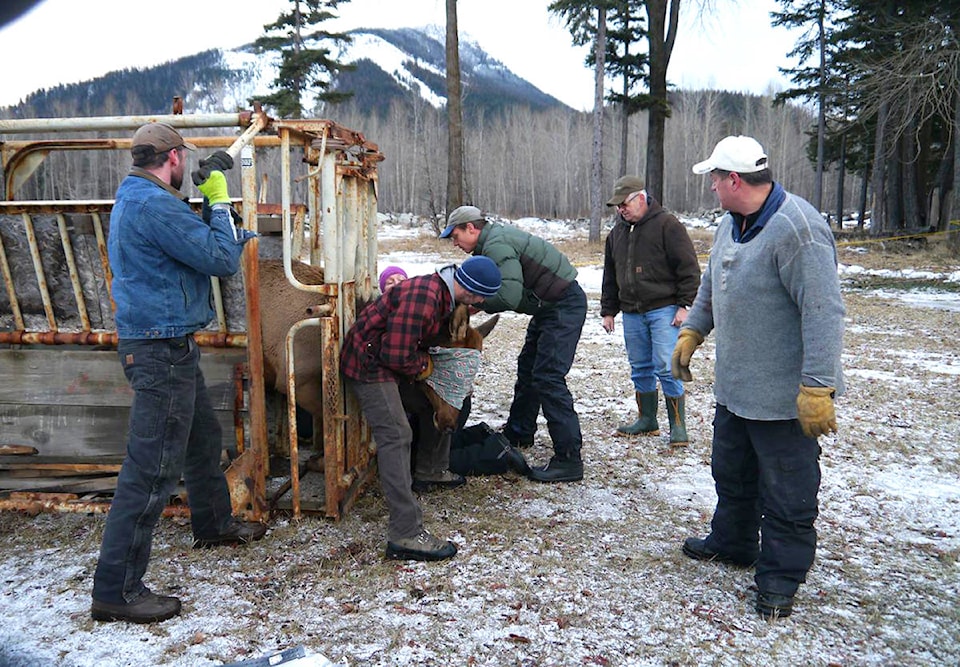Certified biologist, Kim Poole, teamed up with Sam Metcalf of the Sparwood Fish and Wildlife Association last year, to try and solve migration issues with elk in the Sparwood region.
The team started collaring elk in January of 2016, and monitoring GPS locations since then. These collars will transmit three years of data to Poole and his team.
This project is fully supported by the Ministry of Forests, Lands and Natural Resource Operations, as they believe they can benefit from information gathered in this study. This project was proposed and initiated over the summer and fall of 2015.
GPS information gathered shows where the elk are travelling within the seasons, how many are migrating compared to how many are not, and also tracks mortality rates between the two groups.
“The main reason [for the project] was to get a better understanding of why we’re seeing a trend of more homesteader elk versus migratory elk,” said Metcalf.
Poole elaborated on the reasoning behind the initiative.
“The information we’re looking for is focused on trying to identify migratory patterns, looking at differences in what elk might have done in the past for migration. In the old days, lots of them used to go up into the mountains during the summer, and now a lot of them seem to be staying in the valleys, in the fields and in the mining properties,” he said.
From a management point of view, actions could be taken to ensure that hunters only target certain parts of the population in certain areas, in order to create a balance. Poole believes that an important discussion is how to better manage animal populations in the future, and if they should do so.
“From a harvesting perspective, if we (Ministry) want to start managing elk, are we targeting the right elk? We want to make sure we’re not putting too much harvest effort on the ones that are migratory, and we want to knock down the ones that are residents,” he added.
Animals that migrate encounter problems in the wild such as being preyed upon by bears, wolves, and other predators. Closer to town, there is less threat for the elk, and numbers rise.
A few elk that were collared last year have been killed, either by vehicle strikes, predation or have died of old age.
Poole expressed that this is a long-term project and it will take several years to compile enough information to come to a conclusion about migratory patterns.
Currently there are 50 elk collared, and the research teams hope to collar 10 more by the end of the season. This is the second and last year of collaring; Poole and his team will now monitor the elk run for the next two to three years.
Elk have been collared as far south as Hosmer, north to the Fording River mine and east to Alberta. Most collars were applied in February and March of last year.
Collaring takes place mostly in the winter months when the elk are on their ranges. In the summer, elk disperse from those areas.
Based on the information gathered in the past year, Poole sees a number of the elk remain in the Sparwood area, while one quarter to one third leave and go east into Alberta or south into the states for the summer.
Unusual movement was found with an elk that was trapped and collared just outside of Sparwood. It travelled all the way up to the Kananaskis Valley for most of the summer and fall before returning to the Kananaskis golf course for the winter.
In order to collar the elk, the animals are first lured into coral-style traps, attracted by alfalfa. When the animal pulls the barrel off of a trigger, the trap closes behind them. Poole and his team will then muster the animals one at a time through a cattle squeeze to process them. The collar is put on, a blood sample taken and the animal is checked and measured for overall health before being released again.
Blood samples are taken to determine if the elk is pregnant at that time. Only females (cows) are tracked because they are the most reproductively important part of the elk population, and they make up a greater portion of the population than the males (bulls). Also, the necks on the bulls swell during rut season when they attempt to attract females in mid-October. This makes it hard to fit a collar properly and to account for the change in size.
“It’s essentially their (cows) survival rate that drives the population,” said Poole.
This has been a challenging winter for Poole and his team, due to the heavy snow loads and the inability to access the traps.
“The trapping has been a bit more of a challenge this winter than it was last winter,” said Poole. “But it is getting done.”
Poole foresees his team of 10 volunteers to be finished trapping within the first two weeks of April.
